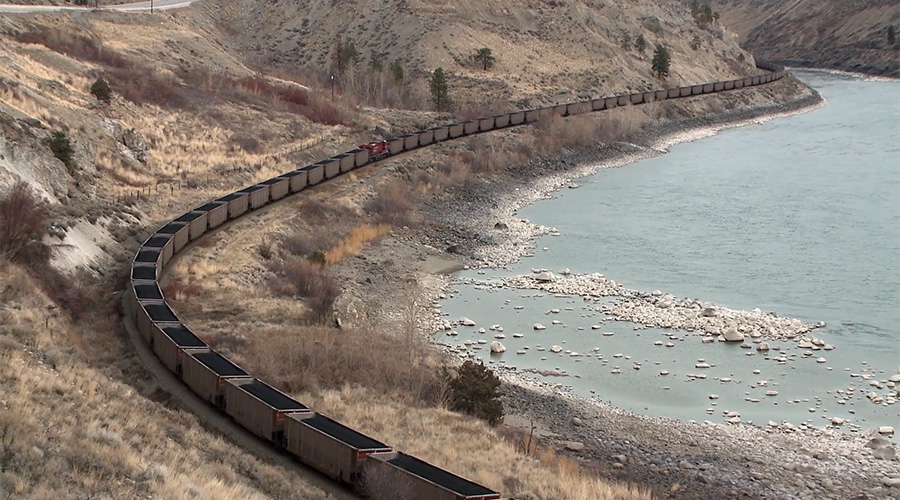Murugappan at rail summit: Technologies will transform BNSF into a safer, smarter railroad
6/2/2021
By Jeff Stagl, Managing Editor
BNSF Railway Co. is analyzing and adopting a lot of emerging information technology (IT) to help the Class I transform, modernize and grow.
It would be difficult, if not impossible, to delve into all of it during a 30-minute keynote address. So BNSF Vice President of Technology Services and Chief Information Officer Muru Murugappan didn’t even try while leading off Progressive Railroading’s virtual summit on May 26.
Instead, Murugappan’s keynote for the virtual event — which was titled “IT Advancements to Meet Organizational Strategy” — described the innovations that are most relevant to BNSF and promise the biggest impacts.
The Class I is investing about $1 billion in technologies, and it isn’t “technology for technology’s sake,” he said. It’s all aimed at making BNSF safer, smarter and more reliable.
Murugappan focused his presentation on IT developments designed to improve the customer experience and enhance image analytics. More accurate, transparent and consistent information and actions can be provided to customers through their preferred digital channels, he said. And using remote imaging sensors and artificial intelligence models can help improve safety, and reduce track and equipment failures.
When it comes to serving and dealing with shippers, the Class I is focused on the full customer experience, said Murugappan, who joined BNSF in 2013 as assistant VP of technology services. Improving every aspect of a customer’s lifecycle is vital, including pricing, the onboarding process (or ways a customer accesses a service), rail-car management, shipment tracking and account status.
The Class I is striving to improve digital visibility to assets and inventory so customers can track their shipments at any point in time and at any location on the railroad’s network; enhance the digital dialogue to ensure integrated, automated and intelligent execution of all transportation and logistics actions; and provide more built-in intelligence, namely analytics, insights and optimization recommendations based on observed activity and patterns.
From a few days to a few minutes
BNSF’s new digital capabilities and enhanced shipper portals have reduced the onboarding turnaround time from a few days to a few minutes, said Murugappan. Systems can talk to systems so shipment management offers shippers more transparency, awareness and efficiency. GIS supports more timely and relevant shipment notifications.
“Customers then can plan their operations better,” said Murugappan.
One emerging aspect of IT that’s crucial to BNSF and others in the rail industry is Application Programming Interfaces (APIs), or software intermediaries designed to enable two applications to communicate with each other. BNSF can take 30 pieces of information that’s important to customers and convert it to APIs, said Murugappan.
“APIs are the future,” he said. “They can enhance the [coming] digital supply chain.”
In terms of image analytics, BNSF is already employing — and not just piloting — a number of technologies to improve equipment inspections, said Murugappan. For example, a new Mechanical Image Driven Analytics System (MIDAS) helps detect wheel defects.
MIDAS is coupled with an equipment monitoring quality system that enables BNSF to cross-reference machine vision system information with other data collected from 4,000 sensors that monitor rolling stock across the network.
 Application Programming Interfaces (APIs) will be key in the future, Murugappan believes. “APIs can enhance the [coming] digital supply chain,” he said.
Application Programming Interfaces (APIs) will be key in the future, Murugappan believes. “APIs can enhance the [coming] digital supply chain,” he said.MIDAS collects 687,000 images and issues 1,100 alerts per day. The system is designed to analyze wheels to the edge, or trackside, based on 14 analytical models and detect anomalies, such as a broken bearing cup or cracked wheel plate, said Murugappan.
To improve the performance of track inspections, BNSF is employing a Track Health Optical Recognition (THOR) system. The rail-bound system — which is mounted on manned geometry cars — is designed to perform track inspections in near-real time and pinpoint defective track conditions.
THOR collects images and processes information on a geometry car traveling up to 70 mph, and can capture 200 images per second. Onboard computers use advanced graphics processing technology and machine vision algorithms to automatically detect defects. The resulting defect information along with supporting images are transmitted within minutes for review and corrective action.
The system can detect broken and cracked joint bars, and missing joint bar bolts. So far, BNSF has inspected more than 45,000 miles of track with THOR, which is integrated with field operations, said Murugappan.
As for ongoing research and development, BNSF is working on an analytical model to identify tie-plate cracks. They are difficult to detect because they typically happen close to welding joints, said Murugappan.
BNSF plans to continue leveraging advanced technologies, such as Big Data, AI, Advanced Network Operations, Movement Planner, Terminal Planner, Electronic Mandatory Directive, Digital GTB, iPad-based work order reporting, and electric locomotives and hostlers.
Murugappan believes such innovations will help the Class I achieve its top objectives: safe operations; more consistent and reliable service; efficient operations; improved asset utilization; a better customer experience; and environmental stewardship.


